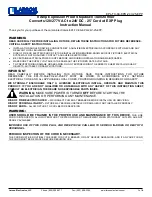
9 of 12
1.8
REMOTE FIRE JACK.
Transmitters that include this optional feature can be actuated remotely through a
two conductor shielded cable plugged into a jack located on the left side of the
transmitter box. The jack accepts a standard 1/8” miniature stereo phone plug.
The cable’s shield connects to the plug’s “shell”, the red lead to the plug’s “tip”,
and the black lead to the plug’s “ring”.
The transmitter is actuated remotely by connecting the tip to the shell (red to
shield) to duplicate the action of the “FIRE A” button, and by connecting the ring
to the shell (black to shield) to duplicate the action of the “FIRE B” button. The
transmitter’s FIRE buttons also remain operational while the cable is plugged in.
NOTE: The transmitter should always be turned off when plugging in or
extracting the remote cable to ensure that no fire commands are
accidentally transmitted if jack contacts should be momentarily shorted
during the insertion or extraction.
1.9
RADIO INTERFERENCE REDUCTION.
For obvious safety reasons, Holatron's design goal is to ensure that data
communication errors due to radio interference or to insufficient signal strength
due to low battery, exceeding specified range, or conductive objects in the signal
path will result in failure of intentional actuation rather than unintended actuation.
This goal is achieved by transmitting a 64 bit noise-tolerant code repeatedly while
a transmitter button is depressed. 60 of these bits must match the pattern
expected by the receiver. Thus, there is one chance in (2 to the 60
th
power) of an
actuation occurring due to reception of a random signal. Expressed in decimal
numbers, this is (1.1529 times 10 to the 18
st
power, or 11529 followed by 14
zeroes). This is a probability of 8.6736 times 10 to the -19
th
power (or a decimal
point followed by 18 zeroes followed by 86736). Though this probability of
unintended actuation is extremely small, it cannot be guaranteed to be zero.
Therefore,
it is important that the user not arm the receiver until all persons
who might be harmed by accidental actuation are in a safe area
.
Additional protection is offered by use of 418 MHz as the operating frequency.
This frequency is sparsely used only by low power transmitters with a maximum
range of approximately 100 yards. It is not commonly used by auto security
systems, garage door openers, radio control models, cordless or cellular
telephones, wireless microphones, or two way communications equipment.
Because this system operates in the UHF region, interference from lamp
dimmers, electrical discharges, and other natural sources is also minimal.
No instances of false triggering with this communications technology have been
reported to date.






























